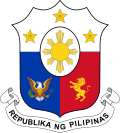History
Cebu was initially composed of one representative district, wherein it elected four representatives, at large, to the Malolos Congress in 1898. It was later divided into seven representative districts in 1907. [1] When seats for the upper house of the Philippine Legislature were elected from territory-based districts between 1916 and 1935, the province formed part of the tenth senatorial district which elected two out of the 24-member senate.
In the disruption caused by the Second World War, two delegates represented the province in the National Assembly of the Japanese-sponsored Second Philippine Republic: one was the provincial governor (an ex officio member), while the other was elected through a provincial assembly of KALIBAPI members during the Japanese occupation of the Philippines. Cebu City, being a chartered city, was represented separately in this short-lived legislative body. Upon the restoration of the Philippine Commonwealth in 1945, the province retained its seven pre-war representative districts; this remained so until 1972.
The province was represented in the Interim Batasang Pambansa as part of Region VII from 1978 to 1984. Beginning in 1984 the province elected six representatives, at large, to the Regular Batasang Pambansa; Cebu City, which became a highly urbanized city in 1979 by virtue of Batas Pambansa Blg. 51, [2] began to be represented separately from Cebu at this time.
Cebu, including the cities of Mandaue and Lapu-Lapu, was reapportioned into six congressional districts under the new Constitution [3] which was proclaimed on February 11, 1987. The six districts elected members to the restored House of Representatives starting that same year.
The passage of Republic Act No. 9726 on October 22, 2009, separated the highly urbanized city of Lapu-Lapu from the sixth district to form its own congressional district starting in the 2010 elections. [4]
Republic Act No. 10684, approved on September 18, 2015, split the second district and recreated the seventh district which elected its own representative in the 2016 elections. [5]
Republic Act No. 11257, approved on April 15, 2019, separated the highly urbanized city of Mandaue from the sixth district to form its own congressional district starting in the 2022 elections.
This page is based on this
Wikipedia article Text is available under the
CC BY-SA 4.0 license; additional terms may apply.
Images, videos and audio are available under their respective licenses.















